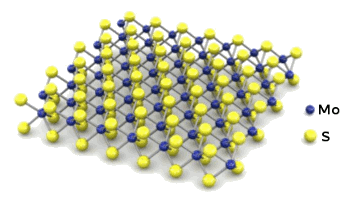Molybdenum Disulfide Circuitry
December 9, 2011
I was introduced to
molybdenum disulfide (molybdenite,
MoS2) very early in my scientific career. As part of my
dissertation project, I had to repeatedly remove and replace a very large
flange in a
vacuum system that operated at high
temperature. The only
gasket material that would work at these tempertures was
copper, and the gasket needed to be
compressed between knife-edges in the flange and seat by tightening a multitude of
stainless steel bolts.
This was a tedious process that involved a
torque wrench, or just my calibrated wrists when I couldn't find the wrench; but the tightening task was made easier by using molybdenum disulfide as a
thread lubricant. Lubrication is the most common use of molybdenum disulfide.
MoS
2 is effective in this application because it's a layered material much like
graphite with easy
slip planes. Now that graphite, in the form of
graphene, is being used for
electronic circuits, it seems logical that molybdenite should be tried as well.

Layered structure of molybdenum disulfide (molybdenite, MoS2).[1]
(Via arXiv Preprint Server))
Electrical engineers at the
Laboratory of Nanoscale Electronics and Structures of the
Ecole Polytechnique Fédérale de Lausanne (Lausanne, Switzerland) have created the first molybdenite
microchips. The chips had two to six
transistors, and they were wired to perform some simple
digital logic operations.[3] They were able to produce
inverters and
NOR gates operable at
room temperature.[2-3] They reported on their devices in
ACS Nano.[2,4]
The
Swiss engineers had investigated the
bulk electrical properties of molybdenite, a naturally occurring
mineral that's relatively abundant, earlier in the year. Its being a
crystallographic analog of graphene, combined with its suitable
semiconducting properties, encouraged further work. One advantage that molybdenite has over
silicon is that it functions as a semiconductor in layers just three
atoms thick.[3]
Transistors made of molybdenite have more gain than those fabricated from graphene.[3] Molybdenite also has
mechanical properties that allow its use in flexible circuitry. I've never really seen the need for "roll-up" devices, but if they become poular, molybdenite can be used to make them. Molybdenite transistors would be useful for
wearable electronics.[3]

What could be simpler?
A molybdenite FET.
(Illustrated using Inkscape)
In a companion article in ACS Nano, the Swiss research team reported on the mechanical properties of molybdenite. Using techniques borrowed from graphene research, they exfoliated molybdenite layers and placed them over microfabricated circular holes in a silicon wafer. They were able to deform these few atomic layer membranes with an
atomic force microscope.[4]
The in-plane
stiffness of a MoS
2 monolayer is 180±60 N/m. This value translates to a
Young's modulus of 270±100
GPa, which is about the same as
steel. As can be expected for a
defect-free crystalline material, these membranes sustained
strains of 6-11% before breaking. The average breaking stength was 23 GPa.[4]
One possible advantage that atomic layer semiconductors, such as graphene and molybdenite, may have in practical applications is that
short channel field effect transistors fabricated on thin layers are expected to have better properties than those made from other materials.[2]
References:
- M.M. Benameur, B. Radisavljevic, S. Sahoo, H. Berger and A. Kis, "Visibility of dichalcogenide nanolayers," arXiv Preprint Server, June 5, 2010.
- Branimir Radisavljevic, Michael Brian Whitwick and Andras Kis, "Integrated Circuits and Logic Operations Based on Single-Layer MoS2," ACS Nano, Article ASAP, November 10, 2011.
- Sarah Perrin, "First Molybdenite Microchip," Ecole Polytechnique Fédérale de Lausanne Press Release, December 5, 2011.
- Simone Bertolazzi, Jacopo Brivio and Andras Kis, "Stretching and Breaking of Ultrathin MoS2," ACS Nano, Article ASAP, November 16, 2011.
Permanent Link to this article
Linked Keywords: Molybdenum disulfide; molybdenum; Mo; sulfur; S; dissertation; vacuum flange; vacuum system; temperature; gasket; copper; compression; stainless steel; bolt; torque wrench; thread; lubricant; graphite; slip plane; graphene; lectronic circuit; arXiv; electrical engineer; Laboratory of Nanoscale Electronics and Structures; Ecole Polytechnique Fédérale de Lausanne (Lausanne, Switzerland); integrated circuit; microchip; transistor; digital logic; inverter; NOR gate; room temperature; ACS Nano; Switzerland; bulk electrical properties; mineral; crystal structure; crystallographic; semiconductor; silicon; atom; mechanical properties; wearable electronics; Inkscape; atomic force microscope; stiffness; Young's modulus; GPa; steel; crystallographic defect; crystal; crystalline material; deformation; strain; short channel field effect transistor.